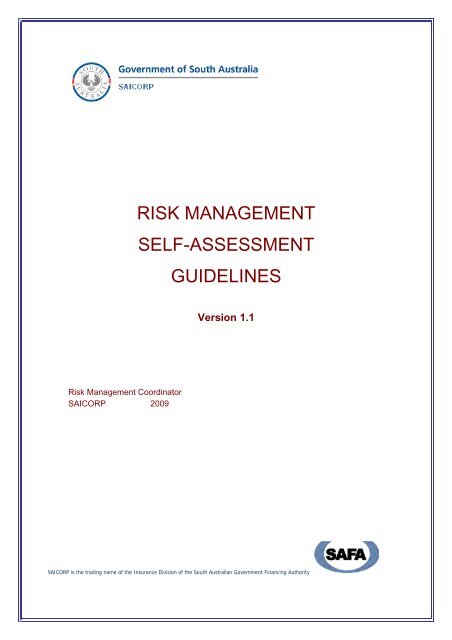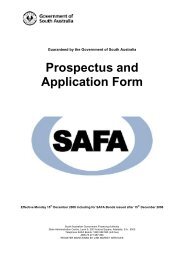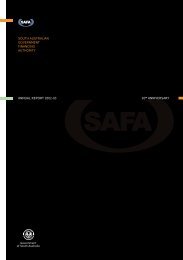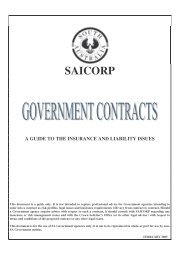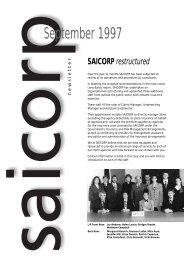RISK MANAGEMENT SELF-ASSESSMENT GUIDELINES
risk management self-assessment guidelines - South Australia ...
risk management self-assessment guidelines - South Australia ...
Create successful ePaper yourself
Turn your PDF publications into a flip-book with our unique Google optimized e-Paper software.
<strong>RISK</strong> <strong>MANAGEMENT</strong><strong>SELF</strong>-<strong>ASSESSMENT</strong><strong>GUIDELINES</strong>Version 1.1Risk Management CoordinatorSAICORP 2009SAICORP is the trading name of the Insurance Division of the South Australian Government Financing Authority
2FOREWORDThe management of risk is an essential element of good governance and is regardedas integral part of sound management practice.Risk management is a key business strategy for Government departments andagencies and much has been achieved in this area over recent times. Through astructured approach to risk management, departments and agencies should achieveimproved business outcomes, whilst enhancing and encouraging the identification ofgreater opportunities for innovation and continuous improvement.The South Australian Government has an endorsed Risk Management PolicyStatement. This policy makes Public Sector Chief Executives accountable to theirMinisters for the development and implementation of a risk management frameworkspecific to the organisation’s business and organisational context. The design of thisframework reflects the principles and the process outlined in the international riskmanagement standard, AS/NZS/ISO 31000.These guidelines provide practical information for agencies undertaking the RiskManagement Self-Assessment and participating in the Risk ManagementBenchmarking program.CONFIDENTIALITYAgencies that participate are assured that all information received by SAICORP isstrictly for the purpose of scoring and coordinating the benchmarking program.Accordingly, all information is regarded as confidential. While SAICORP will need toanalyse the information received, any publication of findings will be in aggregate anda form that will not enable the identification of an individual agency.For enquires regarding the Risk Management Benchmarking program orSelf-Assessment guidelines contact:Darryl BruhnRisk Management CoordinatorSAICORPPhone 8226 3429Email: Bruhn.Darryl@saugov.sa.gov.auSA Guidelines 2009
3CONTENTSSelf-Assessment 4Risk Management Maturity 5Carrying out the self-assessment 5Evidential support for rating 5Summary of Elements and Criteria 6Self-Assessment Guidance 9Elements and CriteriaPrinciples for Managing Risk 10Process for Managing Risk 11Framework for Managing Risk 12Sources of Information 14SA Guidelines 2009
4<strong>SELF</strong>-<strong>ASSESSMENT</strong>Risk Management MaturityThe Risk Management Self-Assessment focuses upon the three elements containedin the recently released International Standards Organisation, Risk ManagementStandard, AS/NZS/ISO 31000:2009, These elements follow the key clauses, namelyPrinciples (clause 4), Framework (clause 5) and Process (clause 6) forManaging the effect of uncertainty on objectives. (i.e. Risk).Each element states specific criteria against which to benchmark currentperformance, together with some guidance on how to interpret the criteria andexamples of verification of achievement.The criteria were developed from the requirements of Government of South AustraliaRisk Management Policy Statement, the Australian/New Zealand Risk Management -Principles Standard, AS/NZS 4360:2004 (now International Standards Organisation,Risk Management - Principles and Guidelines AS/NZS/ISO 31000) and the SADepartment of Treasury and Finance, Treasurer’s Instructions TI Nos. 2 & 28. Theformat draws from similar benchmarking concepts utilised by other TreasuryManaged Funds within Australia.The criteria are not all-inclusive and assessments need not be confined to onlyconsidering the requirements of the above documents. Individual agencies andorganisations should also consider wider issues, including local controls such aspolicies, procedures and compliance programs where they are not already covered.The self-assessment has four levels of risk management, namely:• Basic (0-15%) – minimal organisational awareness of the need for riskmanagement and no structured approach to managing uncertainty;• Initial (16- 50%) – an organisational commitment to managing uncertainty in astructured manner is starting to emerge.• Repeatable (51- 85%) – the assignment of responsibilities and integration of riskmanagement into organisational business processes and across all functions iswell advanced and continues to be consolidated;• Best Practice (86-100%) – the organisation is managing uncertainty in asystematic, structured and timely manner, has developed a risk managementculture and utilises risk management effectively and efficiently to improveorganisational performance.SA Guidelines 2009
5Carrying out the self-assessmentCompletion of this self-assessment will require the involvement of a cross section ofpeople with the knowledge and capacity to openly and honestly examine theworkings of the organisation against the core documents, namely:‣ Government of South Australia Risk Management Policy Statement;‣ Risk Management - Principles and Guidelines on Implementation, AS/NZS/ISO31000; and‣ SA Department of Treasury and Finance, Treasurer’s Instructions 2 & 28.Rating is best undertaken as a team process. The subjectivity of the rating processmeans that group consensus ratings that draw on a wider range of knowledge andexperiences are generally more accurate than an individual’s rating.Evidential Support for RatingThe self-assessment will be undertaken by public sector organisations that will varyconsiderably in terms of organisation size, nature of business environment andfactors such as extent of regional operations. Accordingly, evidence cited supportingthe rating assigned for specific criteria, may vary considerably for participants.The larger, more complex organisations may need to rely on more formalisedsystems while the smaller agencies will be able to meet some criteria with a moreinformal approach. The essence is that the criteria are met in the most appropriatemanner given the organisational circumstances rather than one particular approachbeing better than another.Please note that the actual evidence is not required with the Self-AssessmentWorksheet. The citing of supporting evidence is for your reference and forconsideration when reviewing the benchmarking program.For enquires regarding the Self-Assessment guidelines or participationin the Risk Management Benchmarking program contact:Darryl Bruhn, Risk Management CoordinatorInsurance Services Division, SAICORPPhone: 8226 3429Email:Darryl.Bruhn@sa.gov.auSA Guidelines 2009
6SUMMARY OF ELEMENTS AND CRITERIAELEMENT 1: PRINCIPLES FOR MANAGING <strong>RISK</strong> (Clause 4)This clause requires an assessment of the adherence to the eleven riskmanagement principles and associated behaviours that underpin successfulmanagement of uncertainty within an organisation.1.1 Awareness of the need for a systematic, structured and timely approach tomanaging risk using the risk management process described in AS/NZS/ISO310000.1.2 Executive commitment to risk management demonstrated by appropriatebehaviours.1.3 Acceptance of risk management as a key driver for organisational success.Change management occurring to move from reactive to pro-active mindset.Risk Management facilitates continual improvement and enhancement of theorganisation.1.4 An understanding that the application of risk management discipline willdemonstrate due diligence by the organisation irrespective of the actualoutcome.1.5 Entrenched “way of life” for the organisation. Risk management is accepted asan integral part of “day to day” business operations. Risk management iseverybody’s business.1.6 NEW Risk management takes into account the diversity of the workforce,clients and other stakeholders and considers how this may affect theirperspective of risk.1.7 A Risk is considered at all stages of the life cycle for new and existing programsand services. i.e. from conception to realisation. (Previously 3.5)SA Guidelines 2009
7ELEMENT 3: FRAMEWORK FOR MANAGING <strong>RISK</strong> (Clause 5)This clause requires the assessment of the risk management frameworkdeveloped by the organisation to manage uncertainty in an efficient andeffective manner.3.1A NEW Mandate and commitment to risk management is evident with a policy andthe allocation of resources for risk management.3.1 Responsibilities for risk management clearly delineated to an oversight body,executive and line management. Relationship with Internal Audit functiondefined.3.2 Appropriate systems are available to enable risk registers and associated risktreatment plans to be reported easily and concisely.3.2A Development of a risk management framework that is organic to best meet theorganisation’s business environment, particular objectives and the nature ofthe industry engaged in.3.3 Implementation and maintenance of risk management to include an educationprogram for management and staff to enable them to fulfil their risk managementresponsibilities and increase risk ownership.3.4 The risk management strategy is aligned with the organisation’s goals, andobjectives. The organisation learns and improves its performance throughcontinuous improvement of its systems and processes.3.5 (Now 1.7A)3.6 The program of risk management activity aligns with the organisation’s planning,budgetary and reporting cycle.3.7 Responsibilities are clearly delineated for business continuity, emergencyresponse and disaster recovery planning within the organisation.3.8A The organisation’s core functions and critical systems have been identified,acceptable downtimes estimated and continuity, emergency response, contingencyand recovery plans developed (Previously 2.7).SA Guidelines 2009
8ELEMENT 2: PROCESS FOR MANAGING <strong>RISK</strong> (Clause 6)This clause requires the assessment of the level of awareness, understandingand application of the Risk Management Process defined in AS/NZS/ISO 31000.This includes considering the extent that the Risk Management Process isused by the organisation to maximise the achievement of business andstrategic objectives and performance of programs.2.1 Level of understanding in how to apply the risk management process within theorganisation to consider and manage risk to improve performance.2.2 Now 3.2A2.3 Understanding of risk assessment as per 31000 as a discrete activity of the riskmanagement process involving identification, analysis and evaluation.2.4 Understanding of the necessity to define the specific objectives of the strategic,organisational and business context to provide a focus for risk assessment.2.5 Understanding of the need to be able to describe the essence of risks identifiedaccurately and the underlying root causes.2.6 Levels of risk are compared against pre-established criteria and considerationgiven to the balance between potential benefits and adverse outcomes and overallfeasibility.2.7 Communication and consultation planning as appropriate for risk managementeffectiveness.2.8 Now 3.8A<strong>SELF</strong>-<strong>ASSESSMENT</strong> GUIDANCESA Guidelines 2009
9The following pages contain a set of indicators relating to the elements of riskmanagement maturity to be used for guidance when rating current risk managementpractices. Please note that the examples quoted are not definitive and accordingly donot reflect the only indicators of risk management practices.Every organisation is unique and what may be appropriate for one organisation maynot be appropriate for another. Each organisation must ultimately decide for itselfwhat is “right” for it and how to obtain the maximum value for its risk managementeffort.<strong>RISK</strong> <strong>MANAGEMENT</strong> LEVELBEST PRACTICE3 Management of uncertainty by the organisation isachieved using a framework specifically designed to meetthe organisation’s business context. This framework isunderpinned by risk management principles and theappropriate application of the risk management process.Risk management is regarded as “the way we work” andfundamental to maximising the creation of sustainablevalue.2 A risk management culture is emerging and evident inthe language and the emphasis on using the riskmanagement process within the organisation. Theintegration of risk management into business functions iswell advanced as is the consideration of risk information indecision-making.1 Acceptance of need for a corporate approach to riskmanagement. Initial effort to increase knowledge anddevelop a risk management program commenced orpossibly restarted.BASIC0 Risk management is perceived to relate to hazards,accidents, claims and negative outcomes only. Internalspecialists using specific risk disciplines for each silo ofrisk.Element 1: Principles for Managing Risk (ex-Culture)SA Guidelines 2009
10PRINCIPLES FOR MANAGING <strong>RISK</strong>BasicBest Practice0 1 2 3Re-active with focus onproblem preventionUnderstanding ofprinciples and theirapplication emergingbut still someresistance to overcomeWidespreadacceptance ofprinciples for managingriskPro-active with focus onmanaging uncertaintyto create sustainablevalue“Risk silo” mentalitytowards riskmanagementdiminishing but still themain understandingRisk managementlanguage demonstratesshared understandingof risk managementManaging uncertaintyusing principles formanaging riskembedded intoorganisational cultureResponsible risk takingand learning fromexperience encouragedand supportedRisk managementinformation isconsidered as part of allstrategic and high leveldecision-makingExamples of Verification‣ Establishment of a committee with responsibility for risk management. May be combined with auditor by extending the terms of reference for an existing committee (e.g. quality) or other regularexecutive meeting.‣ Executive and senior management participation in risk assessment‣ Executive presentations to the responsible committee on their business unit’s risk profile.‣ Executive and senior management performance management appraisal to include riskmanagement performance.‣ Risk profile required to be appended to all board and management papers‣ Risk assessment undertaken as part of all business, strategic, project planning activities.‣ Senior and line managers seek advice and assistance on risk management as necessary.‣ Expected standards of ethical behaviour are communicated to all members of the organisation‣ Executive and management behaviour demonstrates the expected standard of ethical behaviour.‣ Engagement of wide range of staff in developing/reviewing risk management policy and proceduresas means of increasing ownership.‣ Current level of risk management maturity assessed using SAICORP self-assessment or similar.‣ Risks are identified and reported even if no treatment is available. Will be monitored thereafter incase a treatment opportunity arises.‣ Senior managers focus on balancing organisational performance and conformance.‣ Responsible risk taking and learning from experience encouraged and supported.‣ Organisation-wide knowledge and belief in the principles of risk management as essential to goodmanagement.‣ Liaison between business units within the organisation regarding common risk management issues.SA Guidelines 2009
11‣ Collaborative work with other government and private organisations on the management of risk.‣ Linked to quality program and/or Corporate Strategy.‣ Outcomes of risk management processes are integrated and support informed decision-making andpriority setting.‣ Risk management personnel professional development supported and encouraged.‣ Executive uses risk management in setting priorities and allocating resources.‣ Stakeholders are identified, particularly those with differing needs, minority and “at risk” groups.Effective system of communication and consultation considers such stakeholders.‣ Planning documentation indicates integration of risk management is accepted and progressing.‣ Risk facilitators/champions attend as observers at Risk Management Committee meetings.‣ Whistle blowing policy, commitment to equity, staff involvement.‣ A clear and shared vision of the organisation’s purpose, values and key outcomes identified.Element 2: Process for Managing RiskPROCESSS FOR MANAGING <strong>RISK</strong>BasicBest Practice0 1 2 3Minimal knowledge andunderstanding of therisk managementprocess prescribed in31000Some awareness of31000, the riskmanagement processand the elements thatmake it upGood understanding ofrisk managementprocess, and how, andwhen it can be used.Still some inconsistencyacross the organisationApplication of the riskmanagement process isfully utilised as a keybusiness toolRisk managementresponsibility isperceived to reside withinternal risk specialists.E.g. insurance, OH & S,ClinicalRisk managementactivities but someconfusion on howrelates to silos of risksuch as OH &S, Clinicaletc.Most appropriateapplication of the riskmanagement processgiven the nature of thebusiness and theenvironment in which itoperates is starting tocrystalliseThe risk managementprocess is usedappropriatelythroughout thebusiness lifecycle andon major projects orany significant activitySome understanding ofindividual elements inthe risk managementprocessRisk assessment isupdated as significantchanges occur inoperational objectivesor circumstancesExamples of Verification‣ Context is clear and specific to whether whole of organisation, divisional or at business unit level andthe reason being undertaken.SA Guidelines 2009
12‣ Stakeholders are identified, particularly those with differing needs, minority and “at risk” groups.Communication & consultation planning appropriate for these stakeholders.‣ Risk assessment undertaken as part of all business, strategic, project planning activities.‣ Risk management procedures, planning and strategy refer to risk management process elements.‣ Risk assessments conducted as part of any policy and procedure development or review, projectsinitiation, or key decision-making process.‣ Checklists, records of past experience, workshop outcomes, systems analysis and scenario analysis.‣ Objectives are built around a strategic plan, reviewed regularly and changed when necessary.‣ Risks are identified and reported even if no treatment is available. Will be monitored thereafter incase a treatment opportunity arises.‣ Regular reports on risk and control self-assessments.‣ Existing controls such as include strategic and business plans, policies, procedures, complianceprograms, delegations, training, qualified personnel, safe work practices, complaints handling andasset registers.Element 3: Framework for Managing Risk (ex-Structures)FRAMEWORK FOR MANAGING <strong>RISK</strong>BasicBest Practice0 1 2 3Risk managementresponsibilities relate tospecific silos of risksuch as OH &S, clinicalrisk, BusinessContinuity, DisasterRecovery, etc only.Risk managementpolicies and procedureswith responsibilitiesassigned including anoversight committee.Commitment tocontinual improvementof risk managementreporting capability,access and education.Staff that are capable ofapplying riskmanagement skills andknowledge at the levelappropriate to them.Reporting on losses,claims, hazards andincidents.Recognition of the needto report on risk “perse” using risk registersis emerging.Coordinated reportingon risk is occurring andincludes performancereporting on “soft”indicatorsFramework developedassists the organisationto respond to changingcircumstances in anefficient mannerEducation commencesand risk managementbecoming integratedinto some businessprocesses. Some basictools available for linemanagement.Substantial integrationof risk into businessprocesses andalignment of riskmanagement activitiesinto business cycle.Framework formanaging uncertaintyrefined to maximise itscontribution toorganisationalperformance.Examples of Verification‣ Establishment of a committee with responsibility for risk management. May be combined with auditor by extending the terms of reference for an existing committee (e.g. quality) or other regularexecutive meeting.SA Guidelines 2009
13‣ Executive responsibility to certify that risks have been identified and rated with appropriate controlsin place.‣ CE accountability for implementing effective risk management standards and practices.‣ Finance & Audit Committee has strong focus on risk management. Reflected in Terms of reference.‣ Risk management promotion, staff surveying and other awareness raising including branding. E.g.PIR<strong>RISK</strong>, TEIRisk.‣ Expected standards of ethical behaviour are communicated to all members of the organisation‣ Engagement of wide range of staff in developing/reviewing risk management policy and proceduresas means of increasing ownership.‣ Current level of risk management maturity assessed using SAICORP self-assessment or similar.‣ Risk management personnel professional development supported and encouraged.‣ Risk management procedures, planning and strategy refer to risk management process elements.‣ Risk management responsibilities stated in job descriptions.‣ Communication plan addresses issues relating to the risk itself and the process to manage it.‣ Compliance program in place to monitor and report on breaches of risk assessment requirements.‣ Engagement of external consultant to support internal specialists. Also contribute to refinement ofthe framework.‣ Executive management determine acceptable level of risk as indicated in risk matrices that arereviewed annually.‣ Risk sources are collated by category using appropriate classification categories in use within theorganisation. Common categories used include Corporate/Strategy, Financial, Human Resources,Information Technology, Operations, Communication, Relationships & Reputation, Property /Assets.‣ “Risk Champions” network established, trained and supported.‣ Risk management education programs, information sessions on risk management.‣ Links between key organisational strategies (operations, finance, HR, IT, OHS&W, etc).‣ Adequate funds and human resources are available to implement the Risk Management Program.SOURCES of INFORMATION‣ AS/NZS/ISO 31000: 2009 (previously AS/NZS 4360:2004), Risk Management – Principles andGuidelines, International Standards Organisation, October 2009SA Guidelines 2009
14‣ Attributes of Enhanced Risk Management, ISO 31000 Annexure A‣ AS 8000, Corporate governance - Good governance principles, Standards Australia, 2003‣ HB 436:2004, Risk Management Guidelines, Standards Australia, August 2004‣ ASX Corporate Governance Council’s Corporate Governance Principles and Recommendations,Principle 7:Recognise and Manage Risk, August 2007‣ Better Practice Guide, Public Sector Governance, Volume 1, Framework, Processes and Practices,Australian National Audit Office, July 2003‣ South Australia’s Strategic Plan 2004 & 2007‣ Risk Management Policy Statement, Government of South Australia, September 2003‣ Controls Assurance Standards 2003/2004 - Information Management and Technology, NationalHealth Service Executive, Department of Health (UK), October 2003‣ ComCover Risk Management Benchmarking, 2001-2007‣ Victorian Managed Insurance Authority, Risk Management Survey, (VIMPAT) 2005‣ Ethical Conduct, Guideline for the South Australian Public Service, Commissioner for PublicEmployment, October 2001‣ Integrated Risk Management Framework: A Report on Implementation Progress - March 2003,Treasury Board of Canada Secretariat, July 2003SA Guidelines 2009


